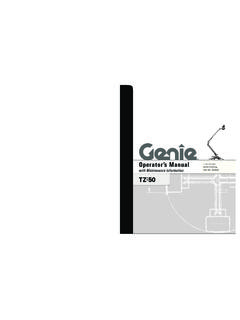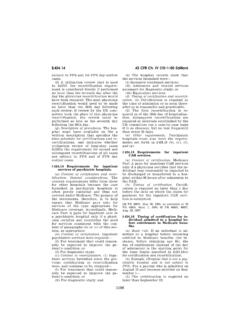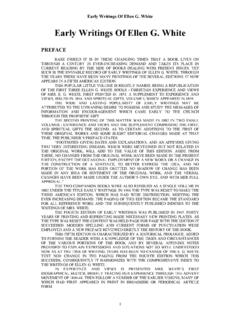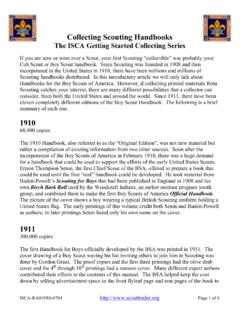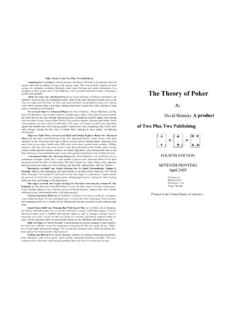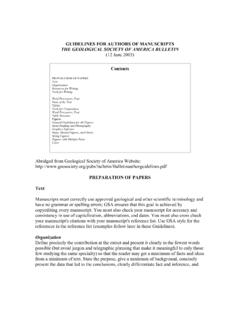Transcription of NAVTEX Manual - Sjöfartsverket
1 NAVTEX Manual 2018 Foreword SOLAS regulation states that Every ship, while at sea, shall maintain a radio watch for broadcasts of maritime safety information on the appropriate frequency or frequencies on which such information is broad-cast for the area in which the ship is navigating . At the request of the IMO Sub-Committee on Radiocommunications, the NAVTEX Manual was first produced in 1988. Three subsequent editions have been produced, with the fourth edition published in 2005 containing amendments endorsed by the Maritime Safety Committee at its sev-enty-eighth session in May 2004 by At its seventh meeting in September 2005, the IHO Commission on the Promulgation of Radio Navigational Warnings (CPRNW)1 established a Working Group to review all World-Wide Navigational Warning Service (WWNWS) documentation.
2 The Working Group included representation from the WMO and firstly prepared revisions to IMO resolutions (17), Promulgation of Maritime Safety Information and (17), World-Wide Navigational Warning Service. The proposed revisions of these resolutions were circulated to IHO Member States under IHB CL 104/2007, endorsed by COMSAR at its twelfth session in April 2008 and subsequently approved by the Maritime Safety Committee at its eighty-fifth session in Novem-ber/December 2008 by and respec-tively. The Working Group then prepared the revised Joint IMO/IHO/WMO Man-ual on Maritime Safety Information incorporating the revised information from resolutions (17), as amended, and (17), as amended. The revised text was circulated to IHO Member States under cover of IHB CL 70/2008, endorsed by COMSAR at its thirteenth session in January 2009 and subsequently approved by the Maritime Safety Committee at its eighty-sixth session in May/June 2009.
3 The Working Group subsequently prepared the third revision of the International SafetyNET Manual . The revised text of the International SafetyNET Manual was circulated to IHO Member States under cover of IHB CL 68/2009, endorsed by COMSAR at 1 CPRNW was renamed the IHO WWNWS Sub Committee (WWNWS) with effect from 1 January 2009. its fourteenth session in March 2010 and approved by the Maritime Safety Committee at its eighty- seventh session in May 2010 by Continuing with the holistic approach of reviewing all maritime safety in-formation documents from the top-down, the Working Group prepared the fifth revision of the NAVTEX Manual . The revised text of the NAVTEX Manual was circulated to IHO Member States under cover of IHB CL 74/2010, endorsed by COMSAR at its fifteenth session in March 2011 and subsequently approved by the Maritime Safety Committee (MSC) at its eighty-ninth session in May 2011 by The sixth revision of the International NAVTEX Manual took place following the second ses-sion of the Sub-Committee on Navigation, Communications and Search and Rescue (NCSR) in June/July 2015.
4 Subsequently it was submitted to the WMO for approval at WWNWS7 prior to submission to NCSR3 for endorsement and final approval at MSC97 and publication as with an in-force date of 1 January 2018. 1 General information NAVTEX is an international automated direct-printing service for prom-ulgation of Maritime Safety Information (MSI), navigational and mete-orological warnings, meteorological forecasts and other urgent safety-related messages to ships. It was developed to provide a low-cost, simple and automated means of receiving MSI on board ships at sea in coastal waters. The information transmitted may be relevant to all sizes and types of vessel and the selective message-rejection feature ensures that mariners can receive MSI broadcasts which are tailored to their par-ticular needs.
5 NAVTEX fulfils an integral role in the Global Maritime Distress and Safety System (GMDSS) developed by the International Maritime Organization (IMO) and incorporated into the 1988 amendments to the International Convention for the Safety of Life at Sea (SOLAS), 1974, as amended, as a requirement for ships to which the Convention applies. This Manual describes the structure and operation of the NAVTEX service. It is intended primarily for use by national administrations and others con-cerned with the preparation and broadcasting of MSI. It will also be of in-terest to seafarers, shipowners and others who need to receive such in-formation in order to safely go about their business at sea. It should be used in conjunction with the Joint IMO/IHO/WMO Manual on Maritime Safety Information (also published as the IHO/IMO World-Wide Navigational Warning Service Guidance Document, IHO Publication S-53).
6 2 NAVTEX service Introduction NAVTEX provides shipping with navigational and meteorological warnings, meteorological forecasts and other urgent safety-related messages (as listed in table 1, section 5) by automatic display or printout from a dedicated receiver. It is suitable for use in all sizes and types of ships. Figure 1 illustrates the way the service is typically structured. Figure 1 Basic concept of the NAVTEX system NAVTEX is a component of the IMO/IHO World-Wide Naviga-tional Warning Service (WWNWS) defined by resolutions (17), as amended, and (27), as may be amended. It has also been in-cluded as an element of the Global Maritime Distress and Safety System (GMDSS). In the GMDSS, a NAVTEX receiving capability is part of the mandatory equipment which is required to be carried in certain vessels under the provisions of the International Convention for the Safety of Life at Sea (SOLAS), 1974, as amended.
7 Authority for coordinating the use of the frequencies 518 kHz, 490 kHz and kHz for NAVTEX services worldwide was delegated by ITU to IMO at WRC-95 through Resolution 339. This was reaffirmed at WRC-97. IMO has vested responsibility for the overall management and coordination of the global NAVTEX service to the IMO NAVTEX Coordi-nating Panel. With respect to national NAVTEX broadcasts on 490 kHz and kHz, the function of the IMO NAVTEX Coordinating Panel is limited to the allocation of transmission identification It should be noted that the provisions of the NAVTEX Manual do not apply when planning a National NAVTEX service on other nationally assigned frequencies. The Terms of Reference for this Panel are attached at Annex 1. Details of operational and planned NAVTEX services are pub-lished periodically in the various national lists of radio signals, in an annex to the International Telecommunication Union s (ITU) List IV List of coast stations and special service stations, and in the GMDSS Master Plan published by IMO in its series of GMDSS Circulars.
8 2 The transmitter identification character is a single letter allocated to each transmitter to identify the NAVTEX station and broadcast times. Definitions For the purposes of this Manual , the following definitions apply: .1 Coastal warning means a navigational warning or in-force bulletin promulgated as part of a numbered series by a National Coordinator. Broadcast should be made by the International NAVTEX service to defined NAVTEX service areas and/or by the International SafetyNET service to coastal warning areas. (In addition, Administrations may issue coastal warnings by other means)..2 Coastal warning area means a unique and precisely de-fined sea area within a NAVAREA/METAREA or Sub-area established by a coastal State for the purpose of coordi-nating the broadcast of coastal maritime safety information through the SafetyNET service.
9 3 Global Maritime Distress and Safety System (GMDSS) means the global communications service based upon automated systems, both satellite and terrestrial, to provide distress alerting and promulgation of maritime safety in-formation for mariners..4 HF NBDP means High Frequency narrow-band di-rect-printing, using radio telegraphy as defined in Rec-ommendation ITU-R .5 In-force bulletin means a list of serial numbers of those NAVAREA, Sub-area or coastal warnings in force issued and broadcast by the NAVAREA Coordinator, Sub-area Coordinator or National Coordinator..6 International NAVTEX service means the coordinated broadcast and automatic reception on 518 kHz of maritime safety information by means of narrow-band direct-printing telegraphy using the English .7 International SafetyNET service means the coordinated broadcast and automatic reception of maritime safety in-formation via the Inmarsat Enhanced Group Call (EGC) system, using the English language, in accordance with the provisions of the International Convention for the Safety of Life at Sea, 1974, as amended.
10 3 As set out in this Manual ..8 Issuing Service means a National Meteorological Service which has accepted responsibility for ensuring that mete-orological warnings and forecasts for shipping are dis-seminated through the International SafetyNET service to the METAREA for which the Service has accepted re-sponsibility under the broadcast requirements of the .9 Local warning means a navigational warning which covers inshore waters, often within the limits of jurisdiction of a harbour or port authority..10 Maritime safety information (MSI)5 means navigational and meteorological warnings, meteorological forecasts and other urgent safety-related messages broadcast to ships..11 Maritime safety information service means the internation-ally and nationally coordinated network of broadcasts containing information which is necessary for safe naviga-tion.
